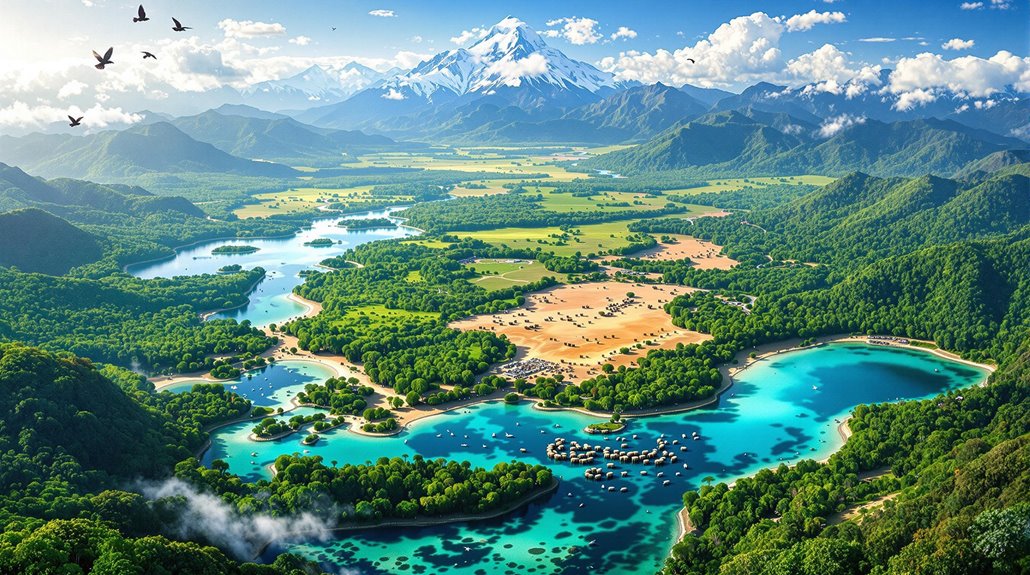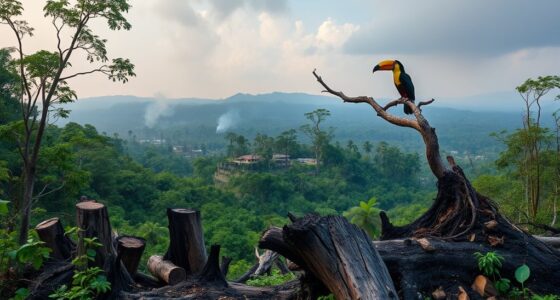Biodiversity is the incredible variety of life on Earth, including plants, animals, fungi, and microorganisms that play essential roles in ecosystems. You can think of it as a rich tapestry woven from different species, each contributing to the balance and health of nature. There are several levels of biodiversity: genetic, species, ecosystem, and habitat diversity. These levels not only enhance resilience against environmental changes but also provide crucial resources for humans, like clean air and food security. The loss of biodiversity poses serious risks, but understanding its layers can reveal much about our planet's natural wonders.
Key Takeaways
- Biodiversity refers to the variety of life forms in ecosystems, including genetic, species, ecosystem, and habitat diversity.
- Genetic diversity provides essential variations for species adaptability and survival against environmental changes.
- High species diversity enhances ecosystem health, resilience, and functionality, supporting vital services like pollination and soil fertility.
- Major threats to biodiversity include climate change, habitat loss, pollution, and invasive species, leading to increased extinction risks.
- Conservation efforts focus on habitat protection, species preservation, and community involvement to sustain and enhance biodiversity globally.
Definition of Biodiversity

Biodiversity, the rich tapestry of life on Earth, includes the vast variety of organisms found in different ecosystems. It encompasses everything from plants and animals to fungi and microorganisms, showcasing life forms at every biological level.
You'll discover genetic diversity, which refers to variations among genes and alleles, and species diversity, highlighting the many species within a region, including those that are rare or endangered. Ecosystem diversity reveals the myriad ecosystems—terrestrial, marine, and aquatic—that support this life.
International definitions emphasize this variability, recognizing its importance for ecological integrity. Ultimately, biodiversity is the foundation of a stable, resilient environment, essential not just for wildlife, but also for human well-being. Understanding it's key to conservation efforts. Additionally, the loss of biodiversity can lead to diminished natural capital, affecting the provision of ecosystem services.
Levels of Biodiversity

Understanding the levels of biodiversity is essential for grasping the complexity of life on Earth. There are four main levels: genetic, species, ecosystem, and habitat diversity.
Genetic diversity refers to the variations within a species, which is critical for long-term survival. Species diversity measures the variety of different species in an area, impacting ecosystem health. Higher genetic diversity enhances adaptability to environmental changes, which is vital for species survival.
Ecosystem diversity encompasses the range of ecosystems, offering unique niches that support various organisms. Finally, habitat diversity highlights the different habitats within ecosystems, where more diverse habitats lead to richer biodiversity.
Each level interacts and contributes to the overall health of our planet, making it important to recognize and protect these layers of life.
Distribution Across the Globe

The intricate layers of biodiversity can be observed in how species are distributed across the globe.
You'll notice that the highest species diversity is found at the equator, where a stable climate and abundant solar energy create ideal conditions for life. As you move towards the poles, diversity decreases due to harsher environments. This pattern of latitudinal gradient illustrates how species richness is maximized in tropical regions.
The species-area relationship shows that larger areas tend to host more species, but this holds true only up to a point.
Biodiversity hotspots, like the Southern Appalachians and California, showcase regions rich in unique and endangered species.
Despite their significance, these areas face threats from urbanization and climate change, making their conservation essential for maintaining global biodiversity.
Importance for Ecosystems

Ecosystems thrive thanks to the intricate web of interactions among various species. These connections play an essential role in maintaining ecosystem functionality.
For instance, pollinators like bees and birds are critical for crop production, while invertebrates enhance soil health necessary for plant growth. Trees and plants also absorb carbon dioxide, helping combat climate change. Additionally, healthy ecosystems provide air and food for humans, highlighting the importance of maintaining biodiversity.
Biodiversity contributes to ecosystem resilience, as removing one species can lead to potential collapse, much like taking a card out of a house of cards. The interdependence of species guarantees stability, enabling ecosystems to adapt to changes.
Furthermore, biodiversity supports food security and provides indispensable resources for medicine and agriculture, making it fundamental for a balanced and thriving environment.
Measurement Techniques

Measuring biodiversity is essential for evaluating the health and functionality of ecosystems, especially given the intricate interdependence of species. You can use various techniques to assess biodiversity. The Rao Coefficient is a promising index for measuring functional diversity, while trait selection and phylogenetic considerations play vital roles. Functional diversity is crucial because it focuses on biological traits within a community, providing insights into ecosystem processes.
Hill Numbers and the iNEXT.3D approach provide a unified framework for integrating taxonomic, phylogenetic, and functional diversity, making comparisons across studies easier. Additionally, incorporating phylogenetic tree branch lengths helps you understand evolutionary relationships among species.
To enhance accuracy, consider sampling effort and species abundance, using asymptotic richness estimators for more reliable assessments. These integrative approaches give you an extensive view of ecosystem diversity and its complexities.
Major Threats

As climate change, pollution, habitat loss, and invasive species threaten biodiversity, understanding these major threats becomes essential for protecting our planet's ecosystems.
Climate change disrupts ecosystems, endangering species like polar bears and coral reefs. It also intensifies droughts, jeopardizing creatures such as the Sonoyta mud turtle. The rapid extinction rates due to climate change are unprecedented in human history.
Pollution, including air, water, and soil contamination, harms over 430 endangered species, creating health issues that can lead to population declines.
Habitat loss is alarming, with forests disappearing at a rate of two football fields per minute, affecting 80% of listed species.
Invasive species outcompete native species, causing ecological disruption and an estimated $20 billion in economic damage annually.
Each of these threats compounds the urgent need for action to preserve biodiversity.
Conservation Strategies

Conservation strategies play an essential role in safeguarding biodiversity and maintaining the delicate balance of our planet's ecosystems.
You can participate in habitat conservation by supporting protected areas like national parks and engaging in habitat rehabilitation efforts such as reforestation. Many of these areas offer camping opportunities that allow you to experience and appreciate the natural beauty firsthand.
Species-based conservation is important too; consider backing captive breeding programs and reintroduction initiatives for endangered species.
Implementing sustainable land-use practices, like responsible agriculture and fisheries management, helps minimize habitat destruction. Additionally, utilizing habitat impact analyses for new developments can greatly reduce negative effects on local ecosystems.
Community involvement is significant; get locals engaged in conservation efforts and take part in educational programs about native landscaping.
Finally, using GIS mapping can help identify and manage critical habitats.
Every action counts in the fight to preserve our planet's rich biodiversity.
Biodiversity and Human Health

Biodiversity is fundamental to your health and well-being, influencing everything from the food you eat to the air you breathe. It provides clean air and fresh water, essential for your daily life. The variety of plants and animals guarantees food security by sustaining soil productivity and offering genetic resources for crops and livestock. Additionally, many medicines come from the rich diversity found in nature, making biodiversity critical for healthcare advancements. However, losing biodiversity can increase disease risks and nutritional deficiencies, threatening your health. By valuing and protecting biodiversity, you help maintain the ecosystem services that regulate pests and diseases, supporting overall health and enriching your community's resilience. One Health approach emphasizes the interconnectedness of human, animal, and environmental health, highlighting the importance of biodiversity in maintaining overall well-being. Your well-being depends on the planet's rich tapestry of life.
Future of Biodiversity

The health of your community and the planet is closely tied to the future of biodiversity. Habitat loss and climate change pose significant threats, leading to declining species and disrupted ecosystems. In addition, natural remedies like turmeric and ginger can play a role in promoting health and resilience in ecosystems by reducing inflammation in both human and environmental contexts.
Human activities like deforestation and overexploitation of resources exacerbate these issues, pushing many species towards extinction. However, there's hope. Halting nature loss is not only a goal but a necessity for sustaining life on Earth.
Technological advancements, such as remote sensing and DNA sequencing, offer powerful tools for conservation. Collaborative efforts across sectors can foster sustainable practices, while global frameworks aim to protect a third of our planet by 2030.
You can contribute too—support conservation initiatives and spread awareness. The time to act is now; every effort counts in preserving the diversity that sustains life on Earth.
Frequently Asked Questions
How Does Biodiversity Affect Climate Regulation?
Biodiversity plays an essential role in climate regulation by supporting various ecosystem services.
When you protect diverse ecosystems, you help enhance carbon sequestration, water cycle regulation, and soil health. These ecosystems, like forests and wetlands, absorb carbon dioxide and maintain water quality.
Each species contributes to these processes, ensuring resilience against climate change. By valuing biodiversity, you're also promoting stability in weather patterns and sustaining the essential services that keep our planet healthy.
What Role Does Biodiversity Play in Agriculture?
Biodiversity plays an essential role in agriculture by enhancing crop resilience and productivity. It provides genetic variation, allowing you to adapt crops to different environmental conditions.
Diverse organisms contribute to vital processes like nutrient cycling, pest control, and pollination, which support healthy ecosystems. By maintaining soil health and regulating water quality, biodiversity guarantees sustainable agricultural practices.
Ultimately, it helps you grow a variety of crops that can thrive under changing conditions.
Can Biodiversity Impact Mental Health and Well-Being?
Yes, biodiversity can greatly impact your mental health and well-being.
When you immerse yourself in diverse natural environments, you experience enhanced sensory stimulation, which can boost your concentration and reduce mental fatigue.
Spending time in such spaces often leads to increased physical activity, releasing mood-boosting endorphins.
Additionally, these environments help lower stress levels by reducing pollutants and fostering a deeper connection with nature, ultimately supporting your overall mental health.
How Does Urbanization Influence Local Biodiversity?
Picture a bustling city, where concrete jungles rise and green spaces shrink.
Urbanization influences local biodiversity by tearing apart habitats and isolating species. As you stroll through the streets, you notice fewer native plants, replaced by invasive species thriving in these altered landscapes.
Pollution chokes the air, while runoff taints nearby waters, pushing local wildlife to the brink.
Ultimately, urban growth not only transforms your surroundings but also diminishes the vibrant tapestry of life.
What Is the Relationship Between Biodiversity and Cultural Diversity?
You'll find that biodiversity and cultural diversity are deeply intertwined.
Indigenous communities often manage local ecosystems, contributing to conservation through traditional practices. Their languages and cultural expressions reflect unique relationships with the environment, enriching biodiversity.
As these cultures fade, so do the ecological insights they provide, leading to a decline in both biological and cultural diversity.
Understanding this connection is essential for effective conservation efforts and maintaining sustainable ecosystems worldwide.
Conclusion
In exploring biodiversity, you've uncovered its crucial role in sustaining ecosystems and human health. The staggering variety of life isn't just beautiful; it's essential for our survival. As you consider the major threats it faces, ask yourself: what can you do to help protect this precious diversity? By embracing conservation strategies and advocating for change, you can be part of the solution, ensuring that future generations inherit a thriving planet rich in life's wonders.









